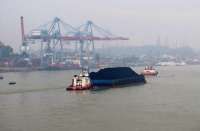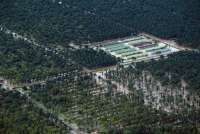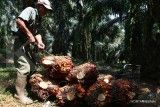JAMBI. A prolonged drought in Jambi province has caused water levels in the Sumatra’s longest waterway, the Batanghari River, to fall while, at the same time, increasing the number of hotspots in the province.
Water levels in a number of areas along the river banks in Jambi city, especially Penyengat Rendah, has further declined and the earth has become parched.
“It has been two months without rain in Jambi city; therefore, the river has ebbed,” said local resident Ahmad on Monday.
“It’s like this every year, usually in February. Eventually, it will rain but it will be followed by another lengthy drought,” he added.
Jambi Disaster Mitigation Agency (BPBD) head Zubaidi AR said the water level in the 800-kilometer-long Batanghari River had dropped to 10 meters.
“There will be some rainfall through April, but the current weather patterns are unpredictable due to climate change,” he added.
The effects of the drought in Jambi province can also be seen in a rising number of hotspots detected in a number of forested areas across the province, most of which are in Tebo regency.
Satellite images from the North Oceanic Atmospheric Administration (NOAA) show that all the hotspots are on private plantations.
In Tebo, seven hotspots were detected, namely in Koto VII district, where two hotspots were located on the PT Lestari Asri Jaya oil palm plantation, while another was found on a plantation managed by PT Arangan HL. In Koto VII Ilir district, a separate hotspot was detected in a concession area, also managed by Lestari Asri.
Two further hotspots were found; one in a Lestari Asri-managed area in Sumay district and the other in an area managed by PT Aldo Mandiri Sukses. The seventh hotspot is on an estate Muaro Tabir district, managed by PT Gamasia Hutani.
In Batanghari regency, four hotspots were detected, one of them on a community-managed plantation in Pemayung district; two of them on an estate managed by PT Sawit Jambi Lestari in Mersam, and the fourth on another community-run estate. In Muara Bulian district, a hotspot was detected on an estate run by
PT Berkah Sapta Palma.
The head of forest protection at Jambi’s Forestry Agency, Agus Srianta, said a prolonged drought and hotspots during the rainy season had never occurred before. He admitted he was also confused by the current weather conditions.
“The Meteorology, Climatology and Geophysics Agency [BMKG] said the drought would arrive in June, but it’s only February and the drought is already here,” he said.
He added that his office would coordinate with firefighting teams from respective regency and municipal forestry offices, as well as other relevant agencies, to put out the fires.
Regarding the fires on company-owned plantations, he said each company was expected to implement their own measures to extinguish the fires.
“We have contacted the companies in question and have told them to extinguish the fires immediately. If a fire is found to be burning in the in the same place the following day, we will pay them a visit,” Agus said.
Sucipto, forest-fire mitigation head with the Jambi Forestry Agency, said his office had been in touch with the provincial administration to discuss the matter.
Last week, the NOAA reported that the number of hotspots in Sumatra had reached 458, of which 243 were in Riau province, which borders Singapore and Malaysia.
Thousands of hectares of forest and plantation land in Riau was destroyed earlier this month due to the fires. (Jon Afrizal)
Severe drought increases hotspots in Jambi
February 18, 2014, 01.24 PM
/2014/02/14/2021067418p.jpg)
ILUSTRASI. Tips Anti Jadi Pengangguran Setelah Lulus Sarjana
Source: The Jakarta Post
| Editor: Asnil Amri
English
Latest News
-
January 09, 2026, 10.09 PM
Global Rice Prices to Stay Weak in 2026 On Surplus Supplies
-
January 08, 2026, 06.57 PM
Indonesia's 2025 Budget Deficit at 2.92% of GDP Nears Legal Ceiling
-
January 08, 2026, 01.37 PM
Indonesia to Set 2026 Coal Output Quota at Around 600 Million Tons, Minister Says
-
January 08, 2026, 12.43 PM
Indonesia Consumes 14.2 Million Kilolitres of Palm-Based Biodiesel in 2025, up 5.2%
-
January 07, 2026, 05.22 PM
Indonesia May Seize Another 5 Million Hectares of Palm Oil Plantations in 2026
-
January 06, 2026, 06.18 PM
European Stocks Rise, Dollar Steadies as Markets Look Past Venezuela Turmoil
-
January 05, 2026, 04.18 PM
Ex-Indonesian Minister Makarim Faces Graft Charges Over Google Laptop Procurement
-
January 05, 2026, 03.20 PM
Indonesia's January-November Palm Oil Export Volume Up 4.3% Y/Y
-
January 05, 2026, 03.14 PM
Indonesia Trade Surplus Less than Forecast, Inflation Quickens











